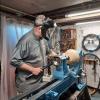I would use CA all the time to save time. Screw chucks are not for endgrain or green soft woods--everything else is OK. If CA glue is a cost thing you sure have a lot of expensive equipment in the pic. You are really talking about a dime per glueblock use.





 Reply With Quote
Reply With Quote







